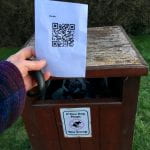“spaces we move through are media that tell stories” (Ritchie, 2013)
Ritchie (2014:53) describes “transmedia” stories [which] “blur the line between storyworld and physical world, requiring that authors tell stories across a variety of media, including architectural space and the physical environment.” My case study this week is an actionbound I have built on a web browser and played on a mobile phone to gain first hand experience of designing and using media that can “blur the line between storyworld and physical world”.
My actionbound topic is a dog walk, because it is a daily activity which does not obviously or intrusively involve technology. The walks are a simple physical exercise, so I was interested to see how the actionbound I designed could add a new dimension of “navigating across digital and physical spaces” (Ritchie, 2014: 65).
Ritchie (2014: 55) explains that “design choices and materials of everyday things afford and constrain the behaviors of users”. In this case study, the affordance I experienced from playing the bound was the gamification. An uneventful walk through quiet streets and empty parkways became a game, and therefore more interesting. There was though an effort required to play the game, which Ritchie (2014: 57-56) describes as “”nontrivial effort””. He warns that “the narrative must offer a reward perceived to be greater than the effort required by the audience” and I don’t think my simple actionbound achieved that.
My actionbound started with an ‘information’ screen to introduce the bound and a ‘mission’ to ‘evidence’ that the player was ready for the dog walk by uploading a photograph taken on the phone’s camera of poo bags and a dog lead. It included a ‘find spot’ [figure 1] using the phone’s ability to use GPS and a map displayed in the app; a second ‘mission’ to find a specific location based on text description and a photograph [figure 2] and upload a similar photograph. There was also a ‘scan code’ [figure 3] to ‘evidence’ that a poo bin was reached in the trail. It concluded with a ‘quiz’ to gauge the time taken to complete the dog walk. The results can be seen in Figure 4.
- Figure 1: Find the spot
- Figure 2: Mission to find location and take photographic evidence
- Figure 3: Scan QR code on poo bin
- Figure 4: Results screen
The experience of playing the bound made me aware of the two distinct worlds of the digital space and physical space. For most of the walk, the digital space was a passive overlay on the physical environment. The “digital bridges” (Ritchie: 2014: 63-64) of finding a spot through GPS and map or text description and photograph, and scanning QR code were active elements that made the story more engaging as a user and demonstrated the “co-authoring” (Ritchie: 2014: 65) aspect of transmedia storytelling.
The actionbound was played in public areas – public roads and public parks, maintained by the local town authorities. I felt like I was appropriating public space for private use when playing the game because I was using the space in a manner that is different to the way I expect it is intended. Adding a QR code to a poo bin was the strongest appropriation because I was making a (temporary) physical change to public property. Berry et al (2013:3-5) points out that there are many ways to understand the term “public” and “[t]he traditional idea of space … has become fundamentally problematized by the presence of media distributing and redirecting data flows that transverse the boundaries of an enclosure”. Therefore, what I perceived as a private use of a public space could instead be understood as a creation of a new dimension of a public space; the production of a “heterogeneous space” that is “comprised of diverse things and qualities”.
References
Berry, C., Harbord, J. & Moore, R.O., (2013). Public space, media space, Basingstoke: Palgrave Macmillan
Ritchie, J. (2013). Ch. 4: Wayfinding on Campus, The mobile story. Available from: http://themobilestory.com/ch-4-wayfinding-on-campus/
Ritchie, J. (2014). The Affordances and Contraints of Mobile Locative Narratives. In The Mo- bile Story. Narrative Practices with Locative Technologies, ed. J. Farman, 53–67. Oxon: Routledge.




